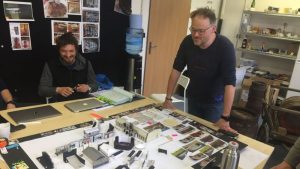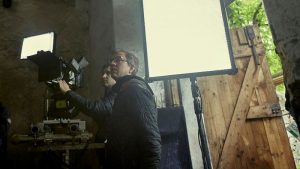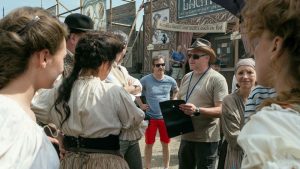
For the historical six-episode Netflix miniseries Oktoberfest: Beer & Blood, Cinematographer Felix Cramer was tasked with recreating early-20th century Munich, Germany. A native of that country himself, Cramer first inundated himself with 100 photos and graphics from the period. “I think, for us, it was really interesting to see how the Oktoberfest—especially because that is our main character in the show—has changed in these years,” said Cramer.
To infuse Oktoberfest: Beer & Blood with accuracy, Cramer and production designer Benedikt Herforth checked maps and images from 1900-era Munich. “I also had a very good collaboration with our costume designer, Michaela Horejsí,” Cramer said from the German location of the series. “She brought historical costumes, and we also added modern-made, but historical-feeling costumes. The production designer did the most research—he was working on the project for two years.”
After a postponement of the series from 2018 to 2019, the filmmakers had additional time to prepare, allowing Cramer, Herforth, and Horejsí the time to study German art from the late-Romantic period. “That was inspirational, concerning the look and the colors of our show,” said Cramer of his distinct visual approach. “It was really important for me to create a color pallette; it’s not just desaturated that you see in so many period pieces—like the sepia tone, the blueish tone. I wanted to create a very specific color pallette that is based on the art of that time. This was developed during the preparation time. We wanted to be very moody and show Munich in a way that it was, because, at that time, it wasn’t just clean and proper.”

Though the producers had lofty aspirations for the appearance of the series, Cramer cited his collaboration with the director of all six Oktoberfest episodes, Hannu Salonen, who encouraged Cramer to create an official style for the entire show. “It was more the director that was the show runner, and, together with him, we created this look,” Cramer revealed.
In shooting digitally, with a specific visual strategy in mind, Cramer chose a camera with which he was previously familiar. “I was used to the Alexa Mini,” Cramer divulged of his 66 days to shoot the series. “I know Alexa so well, and also the way of grading Alexa so well, I felt that this was the perfect combination for me. The camera, at the end, is not the important piece—the important piece is the lens. I had a very intense lens test, and I tried vintage lenses, old lenses, and modern lenses. I came up, by accident, a newly created lens called the Genesis G35 inch Vintage ’66, manufactured by a small, unique company. I knew them, but I hadn’t known that they made this specific lens. When I tested these lenses, I was really blown away by the look. I thought ‘this is absolutely perfect.’”
During his endeavors on the show, Cramer, while crafting a series set in the past, aimed for Oktoberfest to seem fresh and modern. “Our director, Hannu, said ‘Let us go for a really modern way of shooting this history period piece,’” Cramer conveyed. “I used all focal lengths, starting with 14.5mm until 135mm. For me, it’s really important to be with the camera as close to the actors as possible, so I wanted to have this feeling for the audience not to be looking through a window with a lot of distance. I really want to be physically close with my camera to the actors, so I like the wider lenses, because the distance is then small, and then the audience will feel it from my perspective.”

In developing a lighting system for Oktoberfest, Cramer incorporated modern LED technology to maximize the implementation of colors in his lighting schemes. When selecting his gear, Cramer called upon the services of 10 key vendors, including Scenegate in Munich. “My lighting concept wasn’t to be accurate regarding natural light, so, of course, you have the gas lamps and the electric lamps, and they would give you a guideline regarding the colors,” Cramer explained. “As long as we tried to create images that are closer to these late romantic paintings, we also need to change the colors of the lighting. The great thing about LED technology was that you can extremely change the colors of the light—I perfected all colors by grading all the light. For the big exterior scenes, we used sky panels from ARRI, placed on cherry pickers, since the Alexa is a very sensitive camera.”
For his interiors, often shot in archaic buildings in Munich, Cramer’s team placed LEDs in small plastic tubes that were stuck to walls with gaffer’s tape. “You can change the light, and also the color, by using an iPad,” Cramer said of the lighting in the plastic tubes. “For me, it was really great to have these modern options. 10 years ago, we needed much more energy to light these big sets, and, with the LED technology, you save a lot of power.”
In several of Oktoberfest’s striking exterior sequences, Cramer had use of a scissor crane, akin to a lightweight telescope crane. “It’s very small, and it can move the camera three-dimensionally, like a Technocrane,” Cramer described. “It’s so lightweight that you can use this crane in locations that are difficult to access. Since we had two cameras, the A-cam was 90% on that scissor crane. That gave me flexibility I never had before on any other show because you just put it on a stand, and then you move the stand in the next room, and can just shoot and access any angle. My grip perfected the movement of this scissor crane, so the slow movements that you see in Oktoberfest are mainly created by the crane.”

Lastly, in one of the more remarkable shots in the show, Cramer’s camera starts over a central area of the town, comes down to the human eye-level, and proceeds through the crowd. “I had a trainee in my department—I gave him safety gloves, safety glasses and asked him to catch the drone,” said Cramer of a basic drone shot that becomes much more as it progresses. “He would catch the drone, and he developed a special kind of walking technique, because it’s not easy to fly a drone through a crowd of people. We exercised for a week to perfect this movement: the drone flies down, we catch it—of course, the motors are then turned off because they would be dangerous to the extras—then my trainee walked through the crowd and made Steadicam movements. At the beginning, we wanted to do one or two shots, but we ended up doing 10 shots with that technique. To coordinate all the extras, the movement, and everything, it takes time, but, in the end, it was really easy to do.”





